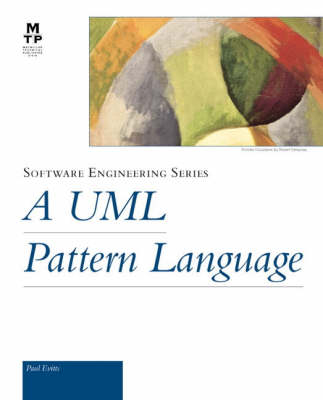
A UML Pattern Language
Sams Publishing (Verlag)
978-1-57870-118-6 (ISBN)
- Titel ist leider vergriffen;
keine Neuauflage - Artikel merken
A UML Pattern Language pairs the software design pattern concept with the Unified Modeling Language (UML) to offer a tool set for software professionals practicing both system modeling and software development. This book provides: a collection of patterns in the domain of system modeling, including those that are useful to management, operations, and deployment teams, as well as to software developers; a survey of the development of patterns and the UML; a discussion of the underlying theory of the patterns and instructions for using the language; a thorough exploration of the design process and model-driven development. A UML Pattern Language recognizes that design and modeling have become equal partners with programming and coding in the enterprise of software development. Providing both an understanding of the work of design and the way patterns and the UML combine to facilitate design.
Paul Evitts is a systems and management consultant from Toronto, and he is the President of neoLogistiks, Inc. He has more than 20 years of experience in systems integration, technology planning and implementation, and software methodology/lifecycle development. Paul's clients have included dozens of private sector and government organizations across North America, including insurance and manufacturing companies, real estate and retail organizations, educational institutions, and financial sector firms. Over the last 10 years, Paul has successfully crafted custom use-case driven development approaches for clients, acted as business architect and project manager for individual projects, and provided strategic planning support for clients migrating to new technologies. His consulting activities have not been limited to traditional applications development and system integration. He has also evaluated business opportunities for systems technology in the Third World (Africa, Latin America, and the Caribbean), acted as technical producer for a commercial CD-ROM published by The Voyager Company, assisted a startup multimedia media company in business planning, and worked as a system architect for one of the significant successes in business re-engineering. Paul's methodology consulting practice has not been limited to object-oriented development. He spent many years in the 1980s providing clients with Rapid Application Development and event-based development approaches, coaching and mentoring modeling using a variety of CASE tools. Before getting into Information Technology, Paul was involved in community development and the use of emerging technologies to promote social change. As a socio-economic consultant, he was an early part of the Inuit Land Claims effort in the Canadian Arctic, which recently culminated in the establishment of a new Canadian Territory called Nunavut. Paul helped the Inuit use video and other media in the process of initial consensus-building across the North, and he provided advice on housing and community planning. His first exposure to the ideas of Christopher Alexander came about earlier as a result of work with a legalized squatting community in London, England¿where he was involved in the cooperative rehabilitation of abandoned neighborhoods. Paul studied community development, politics, and advanced technology at Rochdale College in Toronto. Rochdale is an experimental educational community that he helped establish. It is an alternative to traditional universities. His experiences at Rochdale were recently made into a very popular television documentary in Canada, which aired a number of times by the Canadian Broadcasting Corporation and is available as a video from the National Film Board of Canada. Please refer to Paul's Web site, http://www.umlpatterns.com, for further materials related to this book.
I. GETTING STARTED
1. Pattern Essentials.
Patterns and Paradigms.
Elements of Patterns.
Interpreting the Patterns in This Book.
2.The Unified Modeling Language.
The UML, Briefly Put.
Roots.
Understanding the UML.
Unification: The Methods Wars are Over.
3. UML Essentials, Elements, and Artifacts.
Elements, Viewpoints, and Views.
Packages.
Extension.
Symbols.
Lines.
Diagrams.
Further Reading.
II THE PATTERN LANGUAGE.
4. Patterns of Style.
Catalogue.
Context.
Common Forces.
Discussion.
Summary.
5. Patterns of Substance.
Catalogue.
Context.
Common Forces.
Discussion.
Summary.
6. Domain Patterns.
Catalogue.
Context.
Common Forces.
Discussion.
Summary.
7. Product Patterns.
Catalogue.
Context.
Forces.
Discussion.
Summary.
8. Component Patterns.
Catalogue.
Context.
Discussion.
Summary.
III. ANOTHER STARTING POINT.
9. Patterns in Context.
A Little Starting Context.
The Pattern Idea.
Patterns as Literature.
Types of Software Patterns.
The Roots: Alexander on Patterns and Pattern Language.
A Note on This Language.
The Importance of Patterns.
Where Is It All Going?
10. The UML In Context.
Why Make System Models.
Every Picture Tells a Story: The UML as a Modeling Language.
The UML Specifications and Metamodel.
What Do We Model?
Abstraction and Architecture Made Simple.
Perspectives: A Generic Modeling Framework.
11. Putting It All Together: Reflecting on the Work of Design.
The Work of Design.
Elements of Reflective Design.
To Be Continued...
References.
Index.
| Erscheint lt. Verlag | 23.2.2000 |
|---|---|
| Verlagsort | Indianapolis |
| Sprache | englisch |
| Maße | 185 x 231 mm |
| Gewicht | 476 g |
| Themenwelt | Informatik ► Software Entwicklung ► Objektorientierung |
| ISBN-10 | 1-57870-118-X / 157870118X |
| ISBN-13 | 978-1-57870-118-6 / 9781578701186 |
| Zustand | Neuware |
| Haben Sie eine Frage zum Produkt? |
aus dem Bereich


